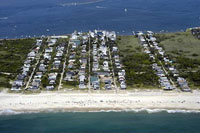
Conversation
with Joe Vietri, Director Of Us Army
Corps Of Engineers National Planning Center Of Expertise For Storm Damage
Concerning Defense Of Gulf Coast And Fire Island
(As anyone knows Joe speaks faster than
the hand moves a pen, or normal fingers type so these are random
fragments covered in a recent conversation) Jeanne
Lieberman
The dune replenishment project is not for recreation beaches it
is to protect the mainland. The majority of benefits are attributable to
replacing the sand on Fire Island to protect L.I.
If scraping is done properly as an effective tool it must be
done at correct time of year Spring and summer when the beach is naturally
replenishing itself not fall and winter when it does not accrue. In Aug the
winds change direction and erode beach so you are stealing saved sand and
reducing the berm
The DEC will create actual sand replacement very far offshore the
deeper the water the bigger the wave. The shallow berms created by scraping
create shorter more destructive waves.
Trapbags: since the time of the Romans people have tried to hold
back the sea with hard structures: GEO Tubes, steel walls have their place but
are very ineffective as a stabilizer except for emergency situations and then
they are recommended
When the Trapbags are not covered (therefore a hard structure) the
waves break on them and energy is redirected (Wave attack retraction and
reflection) which causes more erosion.
The plans will be drafted between Sept and January; easements on
property to be removed are needed by Jan/Feb.
Although stated that the plan must be accepted and executed in
toto
Joe said that it can be done (less effectively) in segments
but he does not mean Saltaire OK, F.H, no skipping towns not
acceptable, he means by half the eastern half or the western as one unit
Officials: Army Corps to restore Fire Island beach
About
30 oceanfront homes on Fire Island will probably be purchased and demolished in
a federally funded program aimed at better protecting the coast of Long Island
from ferocious storms, a U.S. Army Corps official said Saturday.
Seven to
10 additional homes on the barrier island probably can be moved back on their
existing lots to make way for new dunes, said Joseph Vietri, of the Army Corps'
See article below
Originally
published: March 2, 2013 9:18 PM
Updated: March 2, 2013 9:25 PM
By CANDICE RUUD candice.ruud@newsday.com

Photo credit: Randee Daddona | Park Service Ranger MaryLaura
Lamont led a group on a winter's walk on the barrier beach of Fire Island to identify
changes of the landscape created by Superstorm Sandy. (Feb. 24, 2013)
Several
Islip Town and Fire Island
village officials say the U.S. Army Corps of
Engineers appears poised to take on a massive beach replenishment project
that would restore the barrier island's dunes, decimated by superstorm Sandy.
At
an Ocean Beach Village
board meeting Saturday, Mayor James Mallott said the Army Corps is planning to
step in to build dunes 15 feet high by 90 feet wide from Kismet to Davis Park, with the
entire project paid for by the federal government.
"We're
very happy about it," Mallott told residents.
Islip Town Supervisor Tom
Croci said he and other town officials have had several meetings with
representatives from the Army Corps to discuss the project and his
understanding is that the Corps "intended to engage with the beach
replenishment, and that they had been funded to do so."
Saltaire Mayor Robert
Cox told residents at Monday's village board meeting it was "more and more
likely" the Army Corps would take over the islandwide renourishment.
An
Army Corps spokesman said Saturday the scope of the project doesn't fall under
the agency's current legal authority, but that new legal authorities for the
Corps could stem from the recently passed Sandy relief bill, adding that the
bill "is still being interpreted by our higher headquarters."
The
Islip Town board voted in January to bond for $19.9 million for the town's
share of Fire Island beach and dune renourishment, which Croci said was a
backup plan if the Corps doesn't step in.
"But
it looks like the Army Corps is proceeding, and it's really good news for Fire
Island and for Islip," Croci said.
But
the mayors of both Fire Island villages said that while the federal
government's involvement is welcome, it comes at a price: Mallott and Cox said
the project would result in the oceanfront dune line being moved north, which
would mean losing an undetermined number of homes.
Mallott
said the Fire Island National Seashore was on board with the project, and has
been meeting with the Corps to discuss where the new dune line would be.
A
spokeswoman for FINS said Superintendent Christopher Soller has been meeting
with the Army Corps on a variety of projects. Soller was not available for
comment Saturday.
Cox
said the federal government "might decide the dune line is farther north
than we'd like it to be."
Mallott
said it's unclear at this point how far north the dune line will advance, but
that it would be worth losing houses to get the beach renourishment completed
at no local cost.
"The
consensus is that houses on Fire Island would have to go," Mallott said.
"How many, we're not sure. We're going to lose houses if we want to get
that sand. We have one shot at this."
Photo credit: Randee Daddona | Park Service Ranger MaryLaura
Lamont led a group on a winter's walk on the barrier beach of Fire Island to
identify changes of the landscape created by Superstorm Sandy. (Feb. 24, 2013)
Several
Islip Town and Fire Island
village officials say the U.S. Army Corps of
Engineers appears poised to take on a massive beach replenishment project
that would restore the barrier island's dunes, decimated by superstorm Sandy.
At
an Ocean Beach Village
board meeting Saturday, Mayor James Mallott said the Army Corps is planning to
step in to build dunes 15 feet high by 90 feet wide from Kismet to Davis Park, with the
entire project paid for by the federal government.
"We're
very happy about it," Mallott told residents.
Islip Town Supervisor Tom
Croci said he and other town officials have had several meetings with
representatives from the Army Corps to discuss the project and his
understanding is that the Corps "intended to engage with the beach
replenishment, and that they had been funded to do so."
Saltaire Mayor Robert
Cox told residents at Monday's village board meeting it was "more and more
likely" the Army Corps would take over the islandwide renourishment.
An
Army Corps spokesman said Saturday the scope of the project doesn't fall under
the agency's current legal authority, but that new legal authorities for the
Corps could stem from the recently passed Sandy relief bill, adding that the
bill "is still being interpreted by our higher headquarters."
The
Islip Town board voted in January to bond for $19.9 million for the town's
share of Fire Island beach and dune renourishment, which Croci said was a
backup plan if the Corps doesn't step in.
"But
it looks like the Army Corps is proceeding, and it's really good news for Fire
Island and for Islip," Croci said.
But
the mayors of both Fire Island villages said that while the federal
government's involvement is welcome, it comes at a price: Mallott and Cox said
the project would result in the oceanfront dune line being moved north, which
would mean losing an undetermined number of homes.
Mallott
said the Fire Island National Seashore was on board with the project, and has
been meeting with the Corps to discuss where the new dune line would be.
A
spokeswoman for FINS said Superintendent Christopher Soller has been meeting
with the Army Corps on a variety of projects. Soller was not available for
comment Saturday.
Cox
said the federal government "might decide the dune line is farther north
than we'd like it to be."
Mallott
said it's unclear at this point how far north the dune line will advance, but
that it would be worth losing houses to get the beach renourishment completed
at no local cost.
"The consensus is that houses on Fire Island would have to
go," Mallott said. "How many, we're

FIC to FIA Summer Meeting
Gerard Stoddard
LICA
(Long Island Coastal Alliance, a forum for discussion of LI coast-related
matters I created with Dick Curry, former Washington representative for FIA, in
1991).
FIC reaction to the FIA Summer Meeting
The FIA Summer Meeting became the two-thirds-through-the-summer
point for Fire Islanders in the late 1980s. And since the storms of the early
1990s it has also occasioned serious discussion between homeowners, business
people, the National Park Service, the Corps of Engineers and politicians on
how to keep the island in one piece. The meeting also spent time on how Verizon
is trying to get out of its responsibility to provide telephone and DSL service
to Fire Island. If you want to keep it, write a letter saying what loss of the
service means to you personally in terms of medical safety, your business, and
quality of life. Your community association knows who to send it to.
But the main issue, as usual,
was shore protection.
I attended this year's meeting
with Irving Like of Dunewood and found it decidedly more grim than usual.
Last summer he and I agreed that Fire Island would benefit from a new
non-profit-charitable organization, built along the lines of the Central Park
Conservancy, where members are also users of the resource being protected. And
because Fire Island is also unique, and threatened, we intend to explore the
possibility that being designated a Unesco World Heritage Site might help
assure its protection.
But the 2013 FIA Summer Meeting
was aimed at more immediate problems. The main speaker was Joseph R. Vietri, a
regular since the 1993 storm, and now the Corps of Engineers' national go to
person on hurricane protection and recovery. A summer resident of Kismet for
many years, Mr. Vietri qualifies as a prophet not without honor save in his own
country in his own time. This year, his more or less annual prediction that it
would take a truly major storm to focus government attention on Fire Island
seemed to have come true. But, eyeing the smallish crowd before the meeting
started, he observed that at some recent Long Island beach community meetings
the audience was more like a thousand than a hundred. A large majority of those
affected seem willing to let others decide the best course of action.
Here are some of the questions
he tried to answer.
How much money is available for
shore protection?
Congress has approved a Corps
budget for fiscal year 2014 of $5.4 billion. Of this, some $700 million is
tentatively slated for the Fire Island Inlet to Montauk Point (FIMP) project.
The balance is for such areas as the Rockaways, Long Beach, New Jersey and
other places visited by Sandy. Engineers see Long Island's storm damage
recovery and protection in three pieces: mainland Long Island, the barrier
island, and environmental projects where needed. The plan is to spend $500
million on the Long Island mainland to raise houses, roads and infrastructure.
$60 million has been earmarked for mitigation of future storm events on Fire
Island, from the Lighthouse to Smith Point, and the balance will be spent in
locations such as Georgica Pond and Lake Montauk Harbor. Mr. Vietri stressed
that the $700 million is not earmarked. Other states have similar
projects lined up and waiting; Fire Island must use the proposed allocation, or
lose it.
When will the project start?
First of all, some projects
already built are in need of repair that will require new funding. The Fire
Island Inlet and Shores Westerly project (inlet dredged and sand placed on
beaches along Ocean Parkway), and the repair of Westhampton and Georgica Pond
groins are in this category, and federally funded. Projects under study when
Superstorm Sandy came ashore will also have the studies completed at federal
expense. Money lent to the state will be repaid over 30 years. As for timing,
there are five (sometimes six) dredges now operating in New Jersey. These can
be sent to Fire Island quickly. The objective is to get as much protection as
possible by next winter. The required draft Environmental Impact Statement is
due in September for review, and to be in final form by December. It is
critical to get interim stabilization before the coming winter storms.
What can get in the way?
The project can be de-railed by
"the real estate issue". For example, how much sand will have to be placed
on the beach, and what will be the impact of that on first-row owners?
Estimates are that 6 million cubic yards of sand will be needed to build the
beach to an adequate level of protection. A dune built to a height of 15 feet,
with a width of 125 feet at the base, is a lot of sand. (Even so, it would not
be sufficient to absorb the impact of a storm like Sandy; but Sandy will
hopefully not be an annual or even decadal event.) Rebuilding the berm (the
highest area in the middle of the beach) along some 9,400 feet of Fire Island's
ocean beach to a height of 10 feet will take 5 million cubic yards of sand,
about the practical limit of the amount of sand that can be placed in a year.
Beach and dune construction will be from east and west simultaneously. Offshore
bars must also be constructed or repaired.
What about "the real
estate issue"
It seems the impact on houses will
be minimized. Nevertheless, to those affected it will be the primary issue.
Federal officials appear to be focusing on easements. In New Jersey, for
example, some 5,000 easements have already been secured from land owners,
mostly to allow equipment to be placed on the property for a variety of
reasons.
Houses significantly damaged by
Sandy that are south of the Coastal Erosion Hazard Area (CEHA), will be a
special problem. Island-wide, there are some 200 houses south of the CEHA where
these easements may be needed. Additionally, the Corps believes, up to 44
houses, mostly in Ocean Bay Park and Davis Park, will have to be moved or
acquired as part of the project.
Irving Like believes the Fire
Island Conservancy might be able to facilitate the collection of easements from
property owners, where easements are needed by engineers to construct the
project. While owners may not be able to convey the needed easements for cash,
they might be donated to FIC, a charity, which in turn would donate them to the
government. This would establish a charitable deduction from federal income
taxes for the owner. (A similar arrangement was guided by Mr. Like in
protecting the Long Island Pine Barrens.)
It is also true that some
houses may have to be moved north. Some properties are deep enough to allow
this; others might be moved into existing town rights of way, as in Ocean Bay
Park. But there will be a need to purchase and demolish some homes, mostly in
Ocean Bay Park and Davis Park.
Bottom line, there will be no
construction until real estate questions are answered. This won't happen until
there is general agreement on environmental checks and balances, including
easements from ocean front owners that will be permanent. And the Corps is the
only federal agency with the resources and personnel in place now to provide
support for the protection of coastal resources both Fire Island's and the
nation's.
What work will be needed in the
off-shore area?
Joe Vietri said the barrier
island in Sandy performed "as nature intended." That means there was
some landward migration of the barrier; higher in the middle of the island than
at the ends. And, he pointed out, the island is "sinking" as sea
level rises. A rise of one foot per century is the minimum scientists expect,
but some say the rise could be as much as six feet. As for breaching, the
threat is most pronounced on the bay side, which is where most barrier island
breaches originate. On the mainland it is already common to see a mere 1 foot
of freeboard along inlets and docks at high tide. This is why some 5,000
mainland houses in the 10-year floodplain must be raised. (The 100-year
floodplain extends to Sunrise Highway.)
What about the Piping Plover?
Plover issues are expected to
be the least of the problem, although they limit the time window when dredging
can be done. October through March is the normal window. The Corps does not
control this; other agencies do.
Other Questions
The last mapping of the dune
line was in 2007. New York State is supposed to re-map the dune line after
erosion events, but not sooner than one year after a storm. The Environmental
Assessment needed for the project will be completed by September of this year.
The final Environmental Impact Statement should be available for public comment
by the end of 2013.
Beach scraping is not seen as
effective. It puts no new material in the system. Trap boxes will need to be
removed as beaches are worked on. The system has to be natural to function.
Reducing the height of the berm will ease the advancement of the ocean in
storms and lead to erosion and overtopping of dunes. The FIMP project will
treat the entire area as a system, not a collection of disparate parts.
The recent Inter-Agency
Workshops at Stony Brook University, which Irv and I also attended on behalf of
the FI Conservancy, stressed the importance of the back bay system, including
the importance of marsh nourishment and resilience, as in Jamaica Bay. This is
an example of "tiered defense" and will be employed where possible in
the project.
FAIR HARBOR BEACH EROSION CONTROL DISTRICT (FHBECD)
Update August 1, 2013
We are working on several projects and problems.
Scraping
The FHBECD would like to scrape this year to cover the Trapbags and to
widen our dunes. Until now (Aug 1, 2013), the beach has been wide enough but
not high enough to get a DEC permit. We are close, so we are continuing to
monitor and hope for improvement. There is a strict time limit, however, with
project to be completed by August 31, and since a scraping project will have to
be bid by Islip, the logistics may prove insurmountable, even if the low
portion in the beach fills in.
Replenishment
The Army Core of Engineers (ACE) has funding for a major project
and they are ready to proceed. Their environmental study is scheduled to be
ready for agency review in September, and open for public comments soon
thereafter. The plan includes buyout of 30-40 homes in Fire Island. We don't
think that any Fair Harbor properties are at risk, but won't know for sure
until the report comes out. Questions remain as to whether the targeted owners
will agree to be bought out, whether they will be offered reasonable amounts,
and whether they or organizations on their behalf will slow down/stop the
project. As dredging can be done only Oct-March, Oct 2014 is believed to be the
earliest it can be started.
If anything holds up the Fire Island project, the funding may be reallocated and
lost to us.
In the meantime, the community sponsored/FEMA subsidized projects are in limbo.
Financial Issues with Islip
At the direction of the Attorney General, Islip is now enforcing
very strict rules on conduct of our work and the contractors eligible to
perform it. These have resulted in major problems getting our contractors paid
for Erosion District work. Since the larger off-island contractors that satisfy
Islip requirements tend to be disinterested in our small jobs, we are now at
risk of not being able to perform the beach maintenance chores that have been
done by the Erosion District in the past, such as dune fencing, planting grass,
and maintaining the watering system.
We will need to work together to deal with upcoming challenges. Please stay
tuned on this.
Erica Fried, Jerome Feder, Judy Corcoran, Wells Newell, Howard Chatzinoff, Stu
Mono, Karen Levinson












